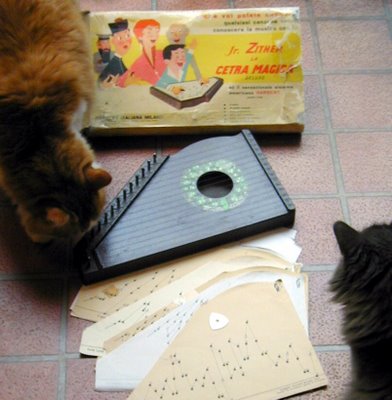Musima Kinder Zither

This children's zither (the literal translation of Kinder Zither) differs a little from the instruments previously shown, in that it is an Akkordzither, having two groups of Chord strings at the left edge (unlike the others, which are normally played with the strings horizontal, this is played with the strings vertical), and only twelve rather than fifteen melody strings.
One's left thumb strums a selected chord group to accompany the melody being plucked with one's right hand. Mostly too much for me so far, but I have given it some tries, and am getting better at it -- though so far at the cost of any relaxation or enjoyment of playing. I'm not sure that there isn't still therapeutic benefit though, so I will keep trying.
Larger versions of Akkordzither can have many chord groups and many more melody strings, and are chromatic rather than diatonic. This zither, and those previously illustrated, are diatonic, meaning the strings correspond to a single key, seven of the twelve notes possible in a a full octave. A chromatic instrument can play in any of the keys, and handle notes with "accidentals" -- the sharps or flats that alter a note from the standard pitch for that key.
You may recognize the shape of this instrument (and to a lesser extent then Harbert Italiana Jr Zither) as being very similar to that of the Autoharp, with most of the strings feeding into an angle, then squared off at the base end. Here, that serves the needs of the chord group, but I'm not sure why it happens on the Autoharp.Though since pianos and true harps have a curved version of the same sort of thing, it probably has an accoustical significance I just don't understand yet.
Musima seems to have been the leading producer of Akkordzithers in its 1953-1990 era. It was a government owned operation in Markneukirchen, in the DDR, also known as East Germany, and like many such concerns, did not do well after German reunification in 1989 threw it into free competition with the world. My zither dates from 1982.
Like my previous zithers, the Kinderzither is also distinguished by under-the-strings note sheets, something Autoharps lack, and soon I will try copying some music sheets from the others, reducing them to fit the narrower string spacing (ignoring the chord strings for now). I will need to choose for the narrow range and different key, so that is not a rush job.
Even with the temporarily limited selection of tunes, this is still good Pluck Play.







